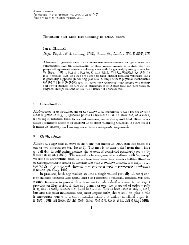Lecture Notes â Cosmology - UCL Astronomy Group
Lecture Notes â Cosmology - UCL Astronomy Group
Lecture Notes â Cosmology - UCL Astronomy Group
Create successful ePaper yourself
Turn your PDF publications into a flip-book with our unique Google optimized e-Paper software.
FORMATION OF STRUCTURE IN THE UNIVERSE<br />
Today we see galaxies, clusters of galaxies and superclusters. How did these structures form<br />
COBE and WMAP have found density fluctuations in the CMB (δρ/ρ = 1 × 10 −5 ). When the Universe<br />
becomes matter-dominated, these density inhomogeneities are amplified by gravity into the structures we<br />
see today. This amplification cannot happen until radiation-matter decoupling because radiation<br />
interacts with the matter.<br />
There is a major problem with this basic picture: the observed fluctuations are too small. If only<br />
ordinary baryonic matter exists in the Universe, the level has to be ∼ 10 −3 for there to be sufficient time<br />
to form the observed structures.<br />
The solution is non-baryonic dark matter (DM) which only interacts gravitationally. Thus large unseen<br />
fluctuations can be present prior to matter-radiation decoupling. When decoupling occurs, the baryonic<br />
matter falls into the deep gravitational wells of DM and structures are created.<br />
The way in which the structures are created depends on whether the DM is ‘cold’ (slow-moving) or ‘hot’<br />
(relativistic).<br />
Cold Dark Matter (CDM) – hypothetical massive, slow moving exotic particles with names like axions,<br />
gravitinos, photinos, or, generically, WIMPs (Weakly Interacting Massive Particles).<br />
Hot Dark Matter (HDM) – fast moving particles (e.g., neutrinos) with a small rest mass (< 10 eV).<br />
CDM evolution – fluctuations collapse and form galaxies first and then clusters and superclusters i.e.<br />
from bottom up.<br />
HDM evolution – fine scale structure (galaxies) is obliterated by free-streaming of fast-moving neutrinos<br />
and large scale structure forms first, and the galaxies form by fragmentation i.e. from top down.<br />
The nature of dark matter remains largely unknown, but numerical simulations of structure formation<br />
strongly favour cold dark matter.











